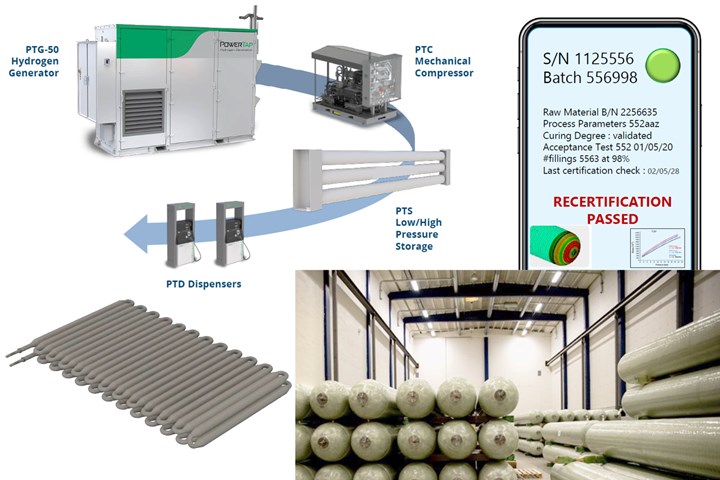CW Tech Days: Composites in the Hydrogen Economy agenda finalized
CW interactive webinar will explore refueling stations, conformable tanks, Type IV glass fiber pressure vessels and in-vessel sensors for process and lifetime monitoring.

Day 2 of CW Tech Days: Composites in the Hydrogen Economy will feature speakers from leaders in hydrogen refueling stations, conformable tanks, glass fiber Type IV pressure vessels and in-vessel sensors for process and lifetime use monitoring. Photo Credit: (top left, counterclockwise): PowerTap Hydrogen, Noble Gas Systems, UMOE Advanced Composites and Com&Sens.
ÂÌñÏ×ÆÞ, the trade publication serving the global composites manufacturing industry, reports that it has finalized the agenda for the upcoming online event: CW Tech Days: Composites in the Hydrogen Economy. It will be held May 18 and May 25, 11:00 a.m.-1:00 p.m. EDT each day.
Using hydrogen to replace fossil fuels has been identified as a sustainable, achievable option for industries and countries to reach zero emissions by 2050. The goal: Reduce the impacts of climate change by controlling emissions and thus keep global temperature rise to 1.5°C above pre-industrial levels. Already, dramatic funding worldwide has been committed to hydrogen production and use, including development projects for transportation, industry and the energy sector.
This rapidly developing hydrogen economy will require storage and transport of compressed hydrogen gas and/or cryogenic liquid hydrogen. Composite pressure vessels and cryo-tanks could offer a doubling of the current industrial carbon fiber market, but there are issues to be addressed regarding storage volume and cost, fiber supply, sustainable production processes, recyclability and the need for improved monitoring during production and lifetime use.
CW will discuss these issues and opportunities during CW Tech Days: Composites in the Hydrogen Economy. Day 1 will focus on design and process developments that could help composite pressure vessels exceed current goals for storage efficiency and reduced cost:
- Ginger Gardiner-CW, Michael Favaloro-CompositeTechs: Introduction Composites Use in Hydrogen Transport and Storage
- David Migacs-CIKONI GmbH: Optimized Digital Designs to Improve Weight Storage in Hydrogen Tanks
- Luke Vardy-Cygnet Texkimp: 3D Winding Technology to Improve Efficiency in Making Hydrogen Storage Tanks
- Dimitrios Sikoutris & Thorsten Groene-Cevotec GmbH: Fiber Patch Placement to Improve Efficiency in Domes of Hydrogen Storage Tanks,
Day 2 will explore the opportunity for storage tanks in refueling stations as well as the potential for some of carbon fiber’s opportunity to be offset via dry fiber conformable tanks and glass fiber Type IV pressure vessels:
- Kelley Owen-PowerTap: The Hydrogen Refueling Landscape
- Chris Kondogiani-Noble Gas Systems: Conformable High-Pressure Storage Tanks - Latest Developments and Outlook
- Øyvind Hamre-Umoe Advanced Composites: T4 HP Cylinders based on Glass Fiber Materials
- Gregoire Beauduin & Geert Luyckx, Managing Director-Com&Sens: Structural Health Monitoring of Composite Structures
today to attend these webinars live or watch at your convenience on-demand!
Related Content
-
High-tension, vertical filament winding enables affordable flywheel energy storage system
French startup Energiestro’s prototype solar energy flywheel-based storage system aims to reduce costs with glass fiber composites and prestressed concrete.
-
ZEBRA project demonstrates closed-loop wind recycling system
Consortium partners have proven the complete recycling of thermoplastic wind turbines via two manufactured wind blades, featuring reduced operating cost, CO2 emissions.
-
Polar Technology develops innovative solutions for hydrogen storage
Conformable “Hydrogen in a Box” prototype for compressed gas storage has been tested to 350 and 700 bar, liquid hydrogen storage is being evaluated.






